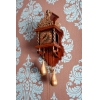|
 Dutch clock aka Cuckoo-Clock
for centuries has been the crucial attribute for home decor. Someone being a
child holds his breath waiting for the next ringing «cuckoo», and every time
thinking that it was about a bird to fly away with the next wave of tiny wings.
Yet, someone admires the masterpieces of German artists, fine carving work on
clock details of the decor made of precious wood, astonishing precision
machinery, and spared no money to buy another copy for his collection. Cuckoo-Clock
is an amazing, intriguing, exciting and luxurious piece of art to boast when
placed at home. Dutch clock aka Cuckoo-Clock
for centuries has been the crucial attribute for home decor. Someone being a
child holds his breath waiting for the next ringing «cuckoo», and every time
thinking that it was about a bird to fly away with the next wave of tiny wings.
Yet, someone admires the masterpieces of German artists, fine carving work on
clock details of the decor made of precious wood, astonishing precision
machinery, and spared no money to buy another copy for his collection. Cuckoo-Clock
is an amazing, intriguing, exciting and luxurious piece of art to boast when
placed at home.
The
birthplace of such a clock is Schwarzwald region in the southwest of Germany. The
population of these lands was famous at making wall clocks as far back as in
the 13thth century. Clock-maker Ketterer, who lived in Schoenwald,
initially tried to build a mechanism with the voice of a rooster, but because
of the cumbersome design and the complexity of playing «crow» stopped at the
tiny bird - a cuckoo. century. However, the first wooden cuckoo-clocks appeared
only in the 17
The clocks
that time were made of wood different from craftsman to craftsman. The carved
clocks were a kind of local «currency», as the Schwarzwald farmers traded their
handicrafts for household articles, food, grain, and clothing. Shortly after
the appearance of the «cuckoo», wooden clocks have become very popular outside Schoenwald.
In 1740, with the invention of the reverse anchor escapement mechanism and long
pendulum, the clocks of German artists have become famous in England, Italy
and France.
The German peasants began to create their own workshops with lots of
students, and the field works took the second place, and eventually lost the
major source of any income. Each
«collection» of clock was unique, as the local artisans possessed the art of
wood carving in perfection. In the middle of the 19th century in the
German watch-making has been established in full force, large companies began
to open up, for example, «Schlenker & Kinzle», «Mauthe», «Urgos» and many
others. Now the Cuckoo-clocks reshaped the look familiar to all like the
forest house with a roof made of oak or fir twigs, cones and other elements,
and come a true work of art.
In the
famous city of Triberg,
Schwarzwald region, there is a museum-store named «Thousands of clocks», which
presents all kinds of cuckoo-clocks of an exclusive work of local craftsmen. The
price for particular copies is up to several thousand dollars. Here at Triberg
square there is the largest cuckoo-clock, which reach a length of fourteen
meters.
Cuckoo-Clock
from «Patek Philippe» was the most expensive. The Sotheby's put them up for
auction with the estimate of 550 thousand francs, but the final price was 1.196
million. This is quite an interesting copy of the floor cuckoo-clock of 1865
issue with three dial plates show the time of day, day of week and month.
Masters of Schwarzwald
lands up to this day are engaged in manufacturing of exclusive cuckoo-clocks,
only the scales of production and popularity has been changed. The watch
brands of such companies as «Schneider» and «DOLD Urenfabrik» (a factory
«HETTICH Uhrenfabrik») are worldwide known. Artisans working in these
companies, have kept all the old traditions of their predecessors. All models
are executed in a classical style and deservedly take the best places in
private collections and become the luxurious decoration of the interior.
Modern
designers also draw attention to the tiny bird in the clock. True, from the «classics»
in general there is a clockwork and like cuckoo with a house only in there.
«Diamantini
& Domeniconi» Company regularly introduces the works of talented designers.
So, Joseph Barakat from Beirut
presented several variations on the theme «cuckoo-clock». A bird in a helmet counts
every hour from its brick bunker-house, but somehow without the traditional «Cuckoo»"
or the house-box, painted with colored vertical lines, with the cuckoo frozen
in anticipation, from the master Tarabey Pascal. Price range of p «Diamantini
& Domeniconi» roductsis $600 to 700 US.
Bright «orange»
in a glass case with the cuckoo inside is a clock «Organita» from the Italian
manufacturer «Anthropologies». The highlight of this design is that
instead of the bird voices there is a noise of waves rolling on the sea-shore.
Despite
such intriguing vision of the cuckoo-clocks concept, yet the classic models
will never go out of fashion. It is luxurious specimen for real connoisseurs
and collectors of expensive watches done in perfect style.
|